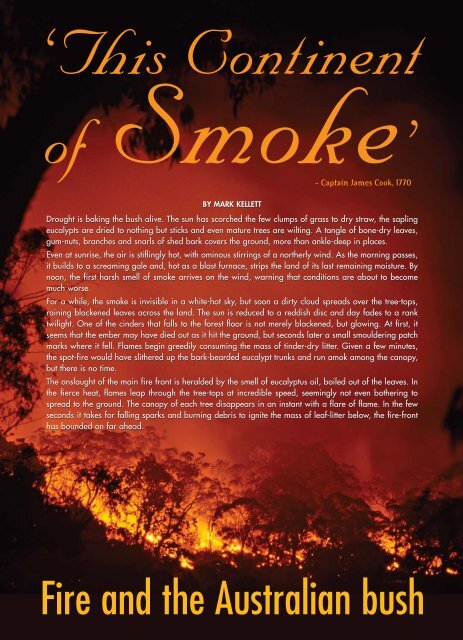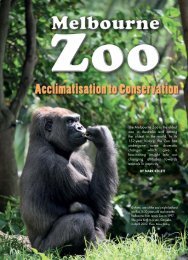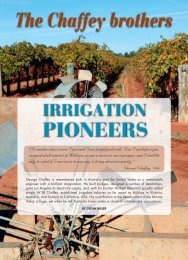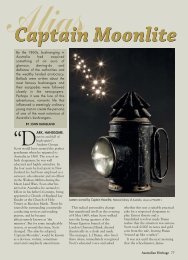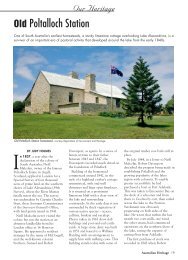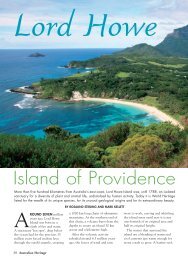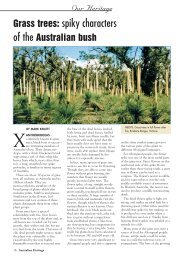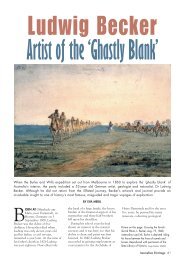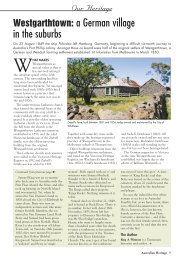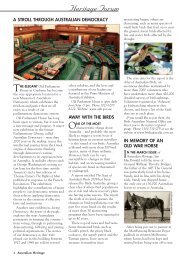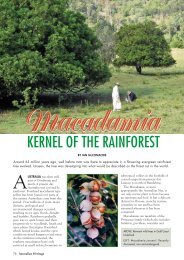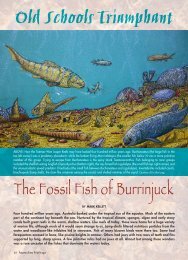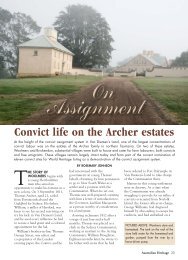Heritage 0308_Bushfire.pdf - Australian Heritage Magazine
Heritage 0308_Bushfire.pdf - Australian Heritage Magazine
Heritage 0308_Bushfire.pdf - Australian Heritage Magazine
Create successful ePaper yourself
Turn your PDF publications into a flip-book with our unique Google optimized e-Paper software.
‘This Continent<br />
of Smoke’<br />
- Captain James Cook, 1770<br />
BY MARK KELLETT<br />
Drought is baking the bush alive. The sun has scorched the few clumps of grass to dry straw, the sapling<br />
eucalypts are dried to nothing but sticks and even mature trees are wilting. A tangle of bone-dry leaves,<br />
gum-nuts, branches and snarls of shed bark covers the ground, more than ankle-deep in places.<br />
Even at sunrise, the air is stiflingly hot, with ominous stirrings of a northerly wind. As the morning passes,<br />
it builds to a screaming gale and, hot as a blast furnace, strips the land of its last remaining moisture. By<br />
noon, the first harsh smell of smoke arrives on the wind, warning that conditions are about to become<br />
much worse.<br />
For a while, the smoke is invisible in a white-hot sky, but soon a dirty cloud spreads over the tree-tops,<br />
raining blackened leaves across the land. The sun is reduced to a reddish disc and day fades to a rank<br />
twilight. One of the cinders that falls to the forest floor is not merely blackened, but glowing. At first, it<br />
seems that the ember may have died out as it hit the ground, but seconds later a small smouldering patch<br />
marks where it fell. Flames begin greedily consuming the mass of tinder-dry litter. Given a few minutes,<br />
the spot-fire would have slithered up the bark-bearded eucalypt trunks and run amok among the canopy,<br />
but there is no time.<br />
The onslaught of the main fire front is heralded by the smell of eucalyptus oil, boiled out of the leaves. In<br />
the fierce heat, flames leap through the tree-tops at incredible speed, seemingly not even bothering to<br />
spread to the ground. The canopy of each tree disappears in an instant with a flare of flame. In the few<br />
seconds it takes for falling sparks and burning debris to ignite the mass of leaf-litter below, the fire-front<br />
has bounded on far ahead.<br />
Fire and the <strong>Australian</strong> bush
FOR MANY AUSTRALIANS,<br />
both past and present, this<br />
terrifying scenario is all too<br />
familiar. Like red-back spiders<br />
and tiger snakes, fire is a constant<br />
threat for those who live in the bush.<br />
The intensity of <strong>Australian</strong> bushfire<br />
is a natural consequence of the forest<br />
that fuels it, but fire in the <strong>Australian</strong><br />
landscape has also been greatly<br />
influenced by people and the changes<br />
they have wrought in the<br />
environment.<br />
Many plants of the <strong>Australian</strong> bush<br />
– in particular, those of the dry<br />
sclerophyll forests and woodlands, and<br />
the semi-arid and desert areas – are<br />
adapted to cope with periods<br />
of drought and the nutrientdeficient<br />
soils of our ancient<br />
continent. Their leaves are<br />
toughened and have relatively<br />
small surfaces to prevent<br />
wilting in dry conditions, and<br />
they are retained for as long<br />
as possible to optimise the<br />
plant’s use of scarce nutrients.<br />
To protect them from<br />
browsing animals, the leaves<br />
are often endowed with<br />
various combinations of tough<br />
surfaces, spikes and<br />
unpalatable chemicals.<br />
A consequence of these<br />
adaptations, however, seems<br />
to be an increase in the frequency of<br />
fire. The same adaptations that<br />
protect the leaves against herbivores,<br />
together with the lack of water, act to<br />
greatly slow down the processes of<br />
decay. Hence when the leaves are<br />
finally shed, they build up along with<br />
branches and bark into a deep mass of<br />
dry litter which is a prime fuel. On<br />
top of this, the chemicals used for<br />
defence by some species of sclerophyll<br />
plant – particularly the eucalypts –<br />
are highly flammable.<br />
With large amounts of fuel on the<br />
forest floor and a canopy stocked with<br />
flammable chemicals above, the bush<br />
needs just a single spark in dry<br />
conditions to become an inferno.<br />
Litter like this shed eucalyptus bark is prime fire fuel.<br />
In response, many bush plants have<br />
evolved ways of surviving fire. Many<br />
eucalypts, for example, can survive<br />
burning and regrow lost foliage from<br />
protected buds. In most species, these<br />
buds sprout from the trunk and<br />
branches, giving the trees a somewhat<br />
fluffy look in the few years after fire.<br />
Others, like mallees and snow gums,<br />
have buds that lie beneath the<br />
ground, and new growth shoots from<br />
the base of seemingly dead trees.<br />
Perennial herbs that form the<br />
understorey of the bush survive fire by<br />
avoidance. They grow during the<br />
cooler and wetter seasons, and die<br />
back in the summer, when fires are<br />
most likely. Their dead stems and<br />
leaves will burn, but the living<br />
underground bulb or tuberous<br />
root mass of the plant survives<br />
to grow again next year.<br />
Many wattles are killed by<br />
fire, but they have a strategy<br />
to survive as a species. Their<br />
seeds, shed in vast numbers<br />
from pods, are induced to<br />
germinate by the heat of fire,<br />
and they then enjoy the<br />
additional benefit of a rich<br />
ashy compost to nourish their<br />
growth.<br />
Plants like the grass trees<br />
(Xanthorrhoea) have a method<br />
of dealing with fire that<br />
combines aspects of those used<br />
64 <strong>Australian</strong> <strong>Heritage</strong>
y eucalypts and wattles. Though their<br />
foliage burns readily, their trunk is able to<br />
survive most fires. Afterwards, they not<br />
only regrow their lost leaves but are<br />
stimulated to flower, so that their seeds<br />
will be set in the nutrient-rich ash.<br />
Though many plants of the <strong>Australian</strong><br />
bush have these superb adaptations to<br />
fire, there are indications that fire was<br />
not always so prevalent in the <strong>Australian</strong><br />
landscape.<br />
For much of Australia’s history, native<br />
conifers like bunya pines (Araucaria),<br />
were common in the northern areas,<br />
while the south was dominated by the<br />
southern beech (Nothofagus). Dry<br />
sclerophyll forests, made up of she-oaks<br />
(Casuarina), eucalypts and wattles<br />
(Acacia), appeared as the continent<br />
become cooler and drier, but ancient and<br />
modern habitats were able to exist in<br />
uneasy equilibrium. Roughly 45,000 years<br />
ago, this balance was upset. The dry<br />
sclerophyll bush lost most of its she-oaks<br />
and expanded dramatically, pushing the<br />
southern beech and native conifers into a<br />
few tiny pockets.<br />
Examination of sediment from many<br />
parts of Australia shows that this<br />
coincided with an increase in the<br />
frequency of fire. Fire certainly has the<br />
potential to contribute to such a change,<br />
for, unlike eucalypts and wattles, native<br />
conifers and southern beech are very<br />
vulnerable to fire and some dry<br />
sclerophyll plants like she-oaks and some<br />
banksias can have difficulty regenerating<br />
if repeatedly burnt.<br />
However, several other aspects of the<br />
<strong>Australian</strong> ecology also changed radically<br />
at about this time, any or all of which<br />
could also have contributed to the<br />
reduction in the ancient flora. The<br />
climate became more variable, possibly as<br />
a result of a change in El Niño and La<br />
Niña weather patterns. The giant animals<br />
known as megafauna, many of which<br />
browsed on shrubs and trees, had by this<br />
time become extinct in some parts of<br />
Australia and rare in others. Finally, the<br />
first humans – the Aboriginal people –<br />
had arrived.<br />
By the time Europeans were becoming<br />
aware of Australia, the Aboriginal people<br />
TOP RIGHT: The dry leaves and resin of grass<br />
trees burn readily during fire.<br />
BOTTOM: After being burnt, grass trees sprout<br />
new leaves and eventually flower.<br />
<strong>Australian</strong> <strong>Heritage</strong> 65
had been regularly burning dry<br />
sclerophyll forest for thousands of<br />
years. Though fire was very common,<br />
leading Captain James Cook to<br />
poetically describe Australia as “this<br />
continent of smoke”, it was not<br />
capriciously started by the<br />
Aboriginals. It was part of a system<br />
termed ‘fire-stick farming’, where the<br />
timing, extent and location of burns<br />
were carefully controlled, usually by<br />
tribal elders. In middle to late<br />
summer, a small area that had been<br />
left to grow for between three to five<br />
years was burnt under close<br />
supervision, as John Lort Stokes<br />
observed during the Beagle’s survey of<br />
the <strong>Australian</strong> coast between 1837<br />
and 1843.<br />
On our way we met a party of natives<br />
engaged in burning the bush, which<br />
they do in sections every year. The<br />
dexterity with which they manage so<br />
proverbially dangerous agent as fire is<br />
indeed astonishing. Those to whom<br />
this duty is especially entrusted, and<br />
who guide or stop the running flame,<br />
are armed with large green boughs,<br />
with which, if it moves in the wrong<br />
direction, they beat it out.<br />
It used to be thought that fire-stick<br />
farming was employed principally as a<br />
means of flushing game towards<br />
hunters. Though doubtless fire was<br />
used for this purpose, regularly<br />
burning the bush had other, longerterm<br />
benefits for the Aboriginal<br />
people.<br />
By opening the bush canopy and<br />
returning the nutrients trapped in<br />
leaf litter to the soil, fires encouraged<br />
the growth of plants which<br />
Aboriginal people liked to eat,<br />
particularly the perennial herbs<br />
whose bulbs and tubers formed an<br />
important part of their diet. Burning<br />
also made hunting easier, both by<br />
promoting the grasses that their game<br />
ate and by keeping the forest open,<br />
which gave a hunter a clearer shot<br />
with his spear.<br />
The general effect of Aboriginal<br />
fire-stick farming was to create a<br />
patchwork forest made up of areas at<br />
various stages of recovery from fire.<br />
Leaf litter was never allowed to build<br />
up, so the fires were low enough in<br />
intensity for established trees to<br />
survive, though young saplings were<br />
often killed. As a result of the grazing<br />
provided by the understorey of herbs<br />
and grasses and control through<br />
regular hunting, many animals had<br />
relatively small, but stable,<br />
populations.<br />
Captain Cook said more than he<br />
knew when he compared the<br />
<strong>Australian</strong> bush to “plantations in a<br />
gentleman’s park”, for it was no more<br />
natural than a plantation or an<br />
orchard. Like those European<br />
artificial habitats, if the management<br />
system was removed, the bush would<br />
rapidly fall to weeds. This is exactly<br />
what happened in uncleared areas<br />
when Aboriginal people were<br />
displaced and no longer exerted their<br />
influence on the forests.<br />
As the seedlings of trees and bushes<br />
were left to reach maturity, the open<br />
forest gradually closed, and<br />
understorey plants were deprived of<br />
light and drowned under a sea of leaflitter.<br />
In some places she-oaks were<br />
Continued on page 68<br />
66 <strong>Australian</strong> <strong>Heritage</strong>
ABOVE: Black Thursday, February 6th 1851, William Strutt, 1825–1915, painting: oil on canvas; 106.5 x 343.0 cm. State Library of Victoria,<br />
Image number H28049.<br />
BLACK THURSDAY<br />
The summer of 1851 had been hot and long, and the country had the appearance of a vast hay-field, blanched by the scorching sun, and<br />
inflammable as tinder. One of the main fires originated at Bullock Creek, near the present Bendigo Diggings, where a scrubby district had<br />
been fired by a shepherd with a view to clear it; the north wind when it rose fanned the kindling flames, and bore them on till they were far<br />
beyond all control. Other fires in no ways connected with that which commenced at Bullock Creek broke out in different directions, and swept<br />
as rapidly onwards.<br />
So frightful was the celerity with which the fire travelled, that the swiftest horse could barely gallop away from it. Mile after mile was traversed<br />
by the flames, and was left a smoking wilderness, with only smouldering ashes to mark the site of once peaceful homesteads. On the great<br />
plains many flocks of sheep fell a prey to the devouring element, and drays that had been left standing, some perhaps with their helpless teams<br />
still yoked, were totally consumed, and only the iron work left remaining.<br />
The mighty sheets of fire hurried on, gaining force and fierceness as they advanced, darting out in long tongues over the parched flats, and<br />
licking up the grass; as they reached the forests the flames curled round the ancient stems, and creeping to the top of the trees flew on from<br />
one tree-top to another, while through the tangled undergrowth below roared a sea of fire. The flakes of burning matter were hurled aloft by<br />
the wind, and borne across creeks and gullies, from one hill-top to another, and lodged on the house-roofs or hay-stacks of the settlers, finding<br />
fresh fuel everywhere.<br />
The heat of the air, which seemed all alight with sparks, became intense, nor was it cooled by the clouds of smoke and cinders that gradually<br />
obscured the brightness of day, and converted it into a lurid and awful twilight. It was not surprising that many anxious persons, who saw<br />
themselves surrounded with fire and smoke on all sides, and knew not whither to fly, gave themselves up for lost, and waited in trembling for<br />
the sound of the last trump.<br />
Extract from Glimpses of Life in Victoria, by ‘A Resident’, John Hunter Kerr, first published in 1876.<br />
<strong>Australian</strong> <strong>Heritage</strong> 67
Bush fire in Australia, Samuel Calvert, 1828–1913, print: col. wood engraving; 32.8 x 45.3 cm. National Library of Australia, nla.pic-an8927792.<br />
able to re-establish themselves, and at<br />
least hold their own against the<br />
eucalypts and wattles. Major Thomas<br />
Mitchell described the change in the<br />
area around Sydney as early as 1838:<br />
Kangaroos are no longer seen there;<br />
the grass is choked by underwood;<br />
neither are there natives to burn the<br />
grass... ...the omission of the annual<br />
periodical burning by natives, of the<br />
grass and young saplings, has already<br />
produced in the open forests nearest<br />
to Sydney, thick forests of young<br />
trees, where, formerly, a man might<br />
gallop without impediment, and see<br />
whole miles before him.<br />
This new, neglected bush was prime<br />
fire territory, and bushfire rapidly<br />
became a frightening part of the<br />
<strong>Australian</strong> experience. Lightning and<br />
desperate attempts by Aboriginal<br />
people to retain the fire-stick system<br />
or to burn out the invaders were<br />
frequent causes of fire, but so was<br />
European ‘burning off’, used to clear<br />
farmland, improve grazing and reveal<br />
hidden mineral deposits, along with<br />
carelessness with fire and arson.<br />
Outlying farms, where Europeans<br />
coexisted with bush to some degree,<br />
were particularly vulnerable, as blazes<br />
from the unmanaged bush outside<br />
could easily spread into farmland in<br />
periods of drought, as David Collins<br />
noted in his Journal in 1792.<br />
At Parramatta and Toongabbe also<br />
the heat was extreme; the country<br />
there too was everywhere in flames.<br />
Mr Arndell was a great sufferer by it.<br />
The fire had spread to his farm, but<br />
by the efforts of his own people and<br />
neighbouring settlers it was got under,<br />
and its progress supposed to be<br />
eventually checked, when an unlucky<br />
spark from a tree, which had been on<br />
fire to the topmost branch, flying on<br />
the thatch of the hut where his<br />
people lived, it blazed out; the hut<br />
with all the outbuildings, and thirty<br />
bushels of wheat just got into a stack,<br />
were in a few minutes destroyed.<br />
In 1838, the assigned convict,<br />
Joseph Mason, noted that farmers had<br />
learned to take precautions to protect<br />
their precious wheat crops: “Most of<br />
the settlers do not sow the headlands<br />
of their fields but leave a border all<br />
around which they plough up & suffer<br />
to remain bare so that the fire may<br />
not run in upon the wheat”.<br />
Fires of this type were a severe<br />
threat to the new <strong>Australian</strong>s and<br />
their property but with a concerted<br />
effort by neighbouring farmers they<br />
were usually contained. However,<br />
after periods of prolonged drought, a<br />
particularly hot day with high winds<br />
could nurture a hellish inferno.<br />
One of the most disastrous of these<br />
firestorms broke out on the 6th of<br />
February, 1851; later dubbed Black<br />
Thursday. Numerous independent<br />
fires, probably started by humans,<br />
raged out of control in many places,<br />
killing ten people and burning up to a<br />
quarter of what would soon after<br />
become the colony of Victoria.<br />
Black Thursday was the first of a<br />
series of firestorms that burned their<br />
way into <strong>Australian</strong> history. Notable<br />
among them are Red Tuesday<br />
(1/2/1898) in which much of<br />
Gippsland was incinerated, killing 12<br />
people and destroying more than<br />
2,000 buildings; Black Sunday<br />
68 <strong>Australian</strong> <strong>Heritage</strong>
(14/2/1926) where fires again hit<br />
Gippsland and southern NSW, and<br />
swept through the Dandenong Ranges<br />
in Victoria, taking 31 lives; the truly<br />
appalling Black Friday fires<br />
(13/1/1939), that burnt a swathe<br />
through Victoria and New South<br />
Wales, killing 71 people; Black<br />
Tuesday (7/2/1967) in which the<br />
whole of Tasmania seemed to catch<br />
fire, taking 62 lives and doing<br />
significant damage to Hobart; the Ash<br />
Wednesday fires (16/2/1983) that<br />
burnt vast areas of Victoria and South<br />
Australia, killing 75 people; and more<br />
recently, the fires of January 18, 2003<br />
that ripped through Canberra and<br />
surrounding areas, killing four people<br />
and destroying more than 500 homes,<br />
and the fires of January 11, 2005 on<br />
the Eyre Peninsula in South Australia<br />
in which nine lives were lost.<br />
The early great fires were the trigger<br />
for the development of Australia’s fire<br />
control organisations. Fire brigades<br />
were established, initially as locally<br />
based voluntary groups, and today<br />
these operate as state authorities<br />
backed by armies of volunteers. Firefighting<br />
is their central role, but<br />
strategies of land and fire<br />
management, including the use of fire<br />
to control fire, are equally important.<br />
Incorporating fire into the firecontrol<br />
system has proved to be a<br />
complex issue. One approach favoured<br />
legislation and fire-fighting forces to<br />
totally suppress fire in the bush.<br />
Though this strategy certainly reduced<br />
the incidence of local fires, the buildup<br />
of litter would eventually fuel<br />
particularly destructive firestorms.<br />
Another system advocated regular<br />
burning as the Aboriginal ‘fire-stick<br />
farmers’ had done. Though this does<br />
serve to reduce the intensity of fires,<br />
the results are unsightly and a<br />
controlled fire can easily become an<br />
uncontrolled one. Further, the process<br />
is damaging when applied to firesensitive<br />
or degraded habitats.<br />
<strong>Bushfire</strong> is inevitable in Australia,<br />
but the question is: are big fires<br />
inevitable or can we learn how to<br />
control them in different types of<br />
landscape? Today, the management of<br />
bushfire in our various landscapes –<br />
from southern forests to the savannas<br />
of the north – is the subject of a great<br />
deal of research. The <strong>Bushfire</strong><br />
Cooperative Research Centre,<br />
established in 2003, has brought<br />
together scientists, fire authorities,<br />
land-management groups and<br />
FIRE IN WET SCLEROPHYLL FORESTS<br />
As its name suggests, wet sclerophyll forest grows in wetter and often cooler areas than its dry counterpart. Though eucalypts dominate this forest,<br />
the milder conditions promote an understorey of many kinds of ferns.<br />
These forests grow in a climate that usually does not encourage fire, and there is no indication that Aboriginal people used their system of firestick<br />
farming in them. However, after periods of prolonged drought, wet sclerophyll will burn readily. Several of the truly devastating fires in<br />
Australia’s history, notably the Red Tuesday and Black Friday fires, have involved bushfire entering wet sclerophyll forest.<br />
Due to the relative rarity of fires, wet sclerophyll plants have different responses to being burnt. The mountain ash, the tallest of the eucalypts, is<br />
killed by fire. However, its gum-nuts are opened by the flames, and take root in the soil almost immediately afterwards. For this reason, most<br />
stands of mountain ash are all of the same size, all having taken root after the same fire.<br />
Though rare and destructive, firestorms are an important factor in shaping the character of wet sclerophyll forests, which, in the absence of fire,<br />
would be displaced by fire-intolerant temperate rainforest.<br />
The wet sclerophyll eucalypt pictured above has been struck by lightning. Unless the land is in drought, the fire has little chance of spreading far.<br />
<strong>Australian</strong> <strong>Heritage</strong> 69
Though the bush appears devastated after fire<br />
(above), many plant species can recover quite<br />
quickly (right).<br />
emergency services from around the<br />
country to improve our understanding<br />
of fire and to develop environmentally<br />
sustainable fire and land-management<br />
strategies.<br />
One thing is clear: fire has played a<br />
major role in creating the <strong>Australian</strong><br />
landscape for a very long time and, if<br />
the predictions about climate change<br />
are correct, bushfires are likely to<br />
become more frequent and more<br />
intense. Without doubt, improving<br />
our knowledge of the relationship<br />
between fire and our environment will<br />
be the key to learning how to live<br />
with the danger of bushfire.<br />
The Author<br />
Dr Mark Kellett is a biologist and<br />
freelance science writer.<br />
Further Reading<br />
Australia Burning: Fire Ecology, Policy and<br />
Management Issues edited by Geoffrey<br />
Cary, David Lindenmayer and Stephen<br />
Dovers, CSIRO Publishing, 2003.<br />
The Future Eaters by Tim Flannery, Reed<br />
Books, 1994.<br />
Burning Bush: A Fire History of Australia by<br />
Stephen J. Pyne, Allen & Unwin,<br />
1992. ◆<br />
70 <strong>Australian</strong> <strong>Heritage</strong>


